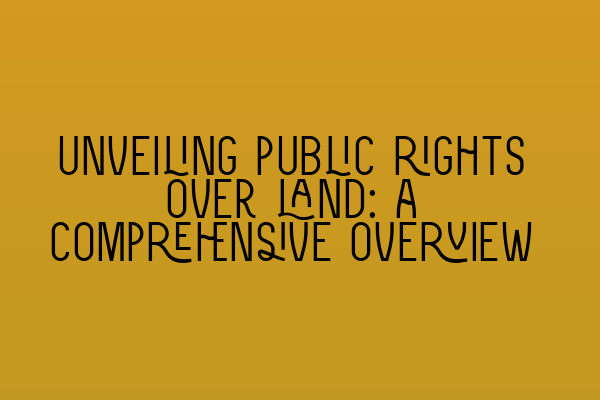Unveiling Public Rights over Land: A Comprehensive Overview
Welcome to SQE Property Law & Land Law, where we provide expert guidance on all matters related to property law. In this comprehensive blog post, we aim to shed light on the intricate topic of public rights over land. It is crucial to understand these rights, as they have the potential to impact property ownership, use, and development.
What are Public Rights over Land?
Public rights over land are legal rights granted to members of the public to use or access certain areas of land. These rights can include public footpaths, bridleways, common land, town and village greens, and public highways. These rights can be extensive and varied, depending on the specific location and legal history.
Understanding public rights over land is essential for property owners, developers, and anyone involved in land transactions or disputes. Failing to consider these rights can lead to legal complications, such as restrictions on development or disputes over access.
The Origins of Public Rights over Land
Public rights over land have their roots in historic common law principles and statutes. They have evolved over time and continue to be shaped by legislation, case law, and other legal developments. It is vital to consult legal professionals with expertise in property law to navigate the complexities of public rights over land.
Types of Public Rights over Land
1. Public Footpaths: Public footpaths are rights of way that allow pedestrians to pass through privately owned land. They are often designated by local authorities and can be found in urban and rural areas. Public footpaths are protected by law and must not be obstructed without legal justification.
2. Bridleways: Bridleways are rights of way that permit pedestrians, cyclists, and horse riders to use specific routes across land. They are distinguishable from public footpaths as their width is sufficient to accommodate horses and bicycles.
3. Common Land: Common land refers to areas of land owned by one or more persons, where the public has the right to engage in certain activities, such as grazing animals, collecting firewood, or fishing. Common land is subject to legal restrictions and regulations that protect both the public’s rights and the landowners’ interests.
4. Town and Village Greens: Town and village greens are areas of land that have accrued recreational use by the local community over a significant period. They are protected by law, and the public has a right to use them for activities such as sports, leisure, and community events. Any proposed development on town or village greens requires a careful assessment of the legal implications.
5. Public Highways: Public highways are roads, footpaths, or bridleways that are maintained at public expense and are available for public use. They provide crucial connectivity between different locations and are subject to specific regulations and legal protections.
Implications for Property Owners and Developers
Public rights over land can have significant implications for property owners and developers. It is essential to carry out thorough due diligence and seek legal advice when purchasing or developing land to ensure compliance with relevant laws and regulations.
When dealing with public rights over land, some key considerations include:
– Identifying and understanding the specific public rights applicable to the land in question.
– Assessing any potential restrictions or obligations associated with public rights, such as access or usage limitations.
– Complying with legal requirements when undertaking any development or alteration to the land.
– Engaging with relevant authorities and stakeholders to address any concerns or disputes related to public rights over land.
Overall, navigating the complexities of public rights over land requires expert legal knowledge and guidance. At SQE Property Law & Land Law, our team of experienced solicitors can provide the assistance you need to understand and manage public rights over land effectively.
For more resources related to SQE exam preparation, please check out our related articles:
- SQE 1 Practice Exam Questions
- SQE 1 Practice Mocks FLK1 FLK2
- SQE 2 Preparation Courses
- SQE 1 Preparation Courses
- SRA SQE Exam Dates
Thank you for reading our comprehensive overview of public rights over land. If you have any questions or require legal assistance, please do not hesitate to contact us.
